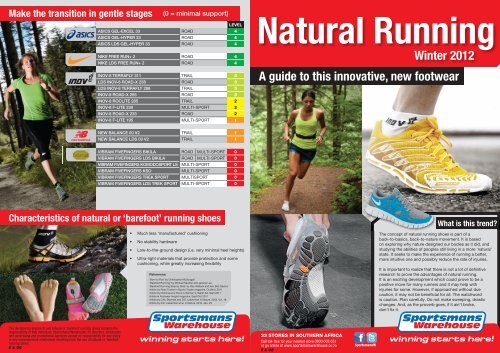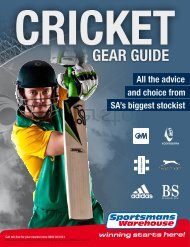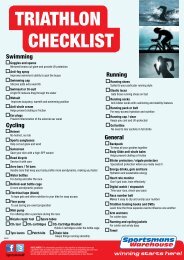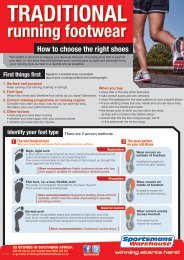Winter 2012 - Sportsmans Warehouse
Winter 2012 - Sportsmans Warehouse
Winter 2012 - Sportsmans Warehouse
You also want an ePaper? Increase the reach of your titles
YUMPU automatically turns print PDFs into web optimized ePapers that Google loves.
Make the transition in gentle stages<br />
(0 = minimal support)<br />
LEVEL<br />
ASICS GEL-EXCEL 33 ROAD 4<br />
ASICS GEL-HYPER 33 ROAD 4<br />
ASICS LDS GEL-HYPER 33 ROAD 4<br />
NIKE FREE RUN+ 2 ROAD 4<br />
NIKE LDS FREE RUN+ 2 ROAD 4<br />
INOV-8 TERRAFLY 311 TRAIL 3<br />
LDS INOV-8 ROAD-X 238 ROAD 3<br />
LDS INOV-8 TERRAFLY 286 TRAIL 3<br />
INOV-8 ROAD-X 255 ROAD 3<br />
INOV-8 ROCLITE 285 TRAIL 2<br />
INOV-8 F-LITE 230 MULTI-SPORT 2<br />
INOV-8 ROAD-X 233 ROAD 2<br />
INOV-8 F-LITE 195 MULTI-SPORT 1<br />
Natural Running<br />
<strong>Winter</strong> <strong>2012</strong><br />
A guide to this innovative, new footwear<br />
NEW BALANCE 00 V2 TRAIL 1<br />
NEW BALANCE LDS 00 V2 TRAIL 1<br />
VIBRAM FIVEFINGERS BIKILA ROAD MULTI-SPORT 0<br />
VIBRAM FIVEFINGERS LDS BIKILA ROAD MULTI-SPORT 0<br />
VIBRAM FIVEFINGERS KOMODOSPORT LS MULTI-SPORT 0<br />
VIBRAM FIVEFINGERS KSO MULTI-SPORT 0<br />
VIBRAM FIVEFINGERS TREK SPORT MULTISPORT 0<br />
VIBRAM FIVEFINGERS LDS TREK SPORT MULTI-SPORT 0<br />
Characteristics of natural or ‘barefoot’ running shoes<br />
• Much less ‘manufactured’ cushioning<br />
• No stability hardware<br />
• Low-to-the-ground design (i.e. very minimal heel heights)<br />
• Ultra-light materials that provide protection and some<br />
cushioning, while greatly increasing flexibility<br />
References:<br />
‘Born to Run’ by Christopher McDougall<br />
‘Barefoot Running’ by Michael Sandler and Jessica Lee<br />
‘Barefoot Running Step by Step’ by Roy Wallack and Ken Bob Saxton<br />
Article by Ross Tucker in Sports Trader magazine, Oct/Nov 2011<br />
Article by Dominique le Roux in Women’s Health SA, Sept 2011<br />
Article in Footwear Insight magazine, Sept/Oct 2011<br />
Article by D.M. Bramble and D.E. Lieberman in Nature, 2004, Vol. 18<br />
Article by D.E. Lieberman et al. in Nature, 2010, Jan. 29<br />
What is this trend?<br />
The concept of natural running shoes is part of a<br />
back-to-basics, back-to-nature movement. It is based<br />
on exploring why nature designed our bodies as it did, and<br />
studying the abilities of peoples still living in a more ‘natural’<br />
state. It seeks to make the experience of running a better,<br />
more intuitive one and possibly reduce the rate of injuries.<br />
It is important to realize that there is not a lot of definitive<br />
research to prove the advantages of natural running.<br />
It is an exciting development which could prove to be a<br />
positive move for many runners and it may help with<br />
injuries for some. However, if approached without due<br />
caution, it may not be beneficial for all. The watchword<br />
is caution. Plan carefully. Do not make sweeping, drastic<br />
changes. And, as the proverb goes, if it ain’t broke,<br />
don’t fix it.<br />
The decision by anyone to use natural or ‘barefoot’ running shoes remains the<br />
responsibility of that individual. <strong>Sportsmans</strong> <strong>Warehouse</strong>, its directors, employees<br />
and advertising and promotional agencies accept no responsibility for any injury<br />
or any consequences whatsoever resulting from the use of natural or ‘barefoot’<br />
running shoes.<br />
E & OE<br />
33 STORES IN SOUTHERN AFRICA<br />
Call toll-free for your nearest store 0800 003 051<br />
or go online at www.sportsmanswarehouse.co.za <strong>Sportsmans</strong>W<br />
E & OE
Are natural shoes only for running?<br />
It appears not. Consumer research in the USA shows that ‘natural’ or ‘barefoot’-type shoes are also used for<br />
(in order of frequency) kayaking, other boating, casual wear, fishing, yoga and several other activities<br />
such as gym and after-sport.<br />
The mechanics of ‘barefoot’ running<br />
versus cushioned running<br />
It is claimed that modern runners,<br />
with access to highly cushioned<br />
shoes, almost all have a hunched<br />
posture, take too-long strides and<br />
land on their heels, which transfers<br />
the impact upwards through ankle,<br />
knee and hip joints.<br />
The claimed benefits of natural running<br />
Stronger muscles, better grip<br />
Evidently running barefoot or in natural shoes strengthens the<br />
stabilizing muscles in the foot and lower leg, which in turn prevent<br />
the foot from over-pronating. In addition the feet can spread out<br />
naturally when landing and thus grip the surface effectively, again<br />
preventing over-pronation.<br />
Enhanced range of motion<br />
Feet, ankles and toes are said to move naturally and,<br />
not constricted by over-firm shoes, achieve a wider range of motion.<br />
Better body posture<br />
With a very much lower heel, the runner’s weight is more evenly<br />
distributed across the footbed and this is said to improve alignment<br />
of the spine.<br />
Enhanced neural function necessary<br />
for balance and agility<br />
The enormous number of neural receptors in the feet conveys<br />
messages about changing terrain and other conditions, thus<br />
enabling the body to adapt optimally.<br />
Improved proprioception and body awareness<br />
Better neurological data is received about the body’s position in<br />
space and its movement.<br />
Possible reduction in injuries<br />
The jury is out on this one, but some proponents claim that<br />
‘barefoot’ runners are less likely to develop tibial stress fractures,<br />
plantar fasciitis and other common injuries.<br />
Conversely, say the enthusiasts, nature’s barefoot runners run with the<br />
body almost upright, the feet almost directly below the hips, and they land<br />
lightly on the forefoot. The foot’s own shock-absorption and the natural<br />
action of the Achilles tendon and calf muscles should provide the correct<br />
support and ‘spring-back’. Some commentators claim that the impact of a<br />
forefoot landing is as little as a third of that of a heel landing.<br />
Leading ‘barefoot’ running footwear<br />
manufacturers, Vibram, have<br />
provided this visual demonstration<br />
of re-training your feet to perfect the<br />
forefoot landing.<br />
Shoes<br />
The possible risks<br />
of natural running<br />
Barefoot<br />
!<br />
South African sports scientist,<br />
Ross Tucker, warns that there are<br />
severe risks involved in getting ‘barefoot’<br />
running wrong. If you run ‘barefoot’,<br />
but land on your heel, the impact loading<br />
rate can be seven times greater than a<br />
heel landing in conventional running shoes.<br />
Plus he points out a second risk, namely<br />
that the switch in load to muscles<br />
and tendons which may not have<br />
experienced this for years, if handled<br />
incorrectly, can cause an unbearable strain<br />
which leads to breakdown.<br />
How to start<br />
Should everybody make the transition<br />
to natural running?<br />
Most commentators agree that it is not for everybody.<br />
Some people who try it will succeed with practice, others will never<br />
do so, either because of other structural problems or because of<br />
irreversible patterns laid down by 20 to 40 years of running in shoes.<br />
Ross Tucker suggests that those with one-off or chronic injuries<br />
may use natural running as part of a holistic therapeutic programme.<br />
Knee problems or any anterior injuries could benefit, because<br />
running ‘barefoot’ switches the load. In addition, chronic calf and<br />
ankle or Achilles tendon problems could improve, but only if a truly<br />
conservative programme is followed.<br />
He counsels that ‘barefoot’ running is probably not for<br />
high-performing runners because they run further, faster and more<br />
frequently than would ever have been done in ‘nature’.<br />
This means that muscle fatigue becomes a factor. In addition,<br />
the very competitive personalities of such runners make them<br />
likely to over-do ‘barefoot’ running.<br />
If it ain’t broke, don’t fix it<br />
Leading sports scientists counsel that if you are injured, first try<br />
running barefoot on grass and, if your injury improves, natural or<br />
‘barefoot’ shoes could help you, as part of a balanced programme.<br />
They warn that if you are happily running half marathons and have<br />
no injuries, you should not change your existing choice of shoes.<br />
natural running<br />
• Ideally consult an expert, such as a podiatrist, first.<br />
• Study and practise the forefoot landing. (See page 2.)<br />
• Before using the forefoot landing on road or trail, first strengthen the<br />
unused, weakened muscles, by initially landing on the outside ball<br />
of the foot, along the outside of the mid-foot.<br />
• Adjust your posture (by engaging your core, standing tall and straight,<br />
opening your chest and relaxing your shoulders).<br />
• Shorten your stride consciously.<br />
• Do not move straight to a ‘barefoot’ shoe.<br />
Rather first try a transitional, natural shoe – that can have some<br />
cushioning, but is flexible and has a big toe box allowing your toes<br />
to spread and grip.<br />
• Proceed very slowly and cautiously. Heed your body’s messages,<br />
monitor your feet and legs, and stop at any sign of pain.<br />
• Follow a conservative programme. There are several to choose from,<br />
e.g. on www.WomensHealthSA.co.za/Fitness or<br />
www.vibramfivefingers.co.za or in the books ‘Barefoot Running’<br />
by Michael Sandler and Jessica Lee or ‘Barefoot Running Step<br />
by Step’ by Roy Wallack and Ken Bob Saxton.







